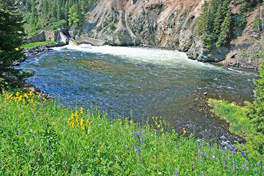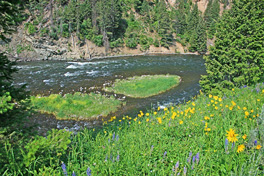Tail Water Streams
Tail water streams are found below dams and their water source flows from the reservoir. The outlet comes from controlled head gates which, releases water out from the bottom of the dam; as a result, the most dense and coldest water is released. It is typically around 39-40°F. However at flood times water can be released over the dams’ safety spillway. This water is derived from the top layer of the reservoir, and contains the warmest least dense water. Occasionally a reservoir is designed to purposely release water from any of its depths. For example, Utah’s Flaming Gorge regulates its outlet flows by adjustable baffles set to expel more favorably temperatured water. Its outlet, the Green River, is optimally controlled to provide water temperatures most suited for aquatic life. The Green River is more like a large spring creek in that its flow is optimal for fish growth. This good fortune has made it a highly productive fishery; although, most other tail waters are not so lucky.
The basic problem of most tail waters is that below their dams they are just too cold for optimal fish


growth. Conditions can become more favorable the further downstream you travel from the dams head gates. The ambient temperature has warmed the chilly flows.
Dams are built for three general proposes: hydropower productions, irrigation and culinary storage, and flood control. Each of these dams has unique features.
Hydropower dams can be subject to daily variances in outlet flows. At peak electricity use times more flow is released to generate power. This causes both a sudden temperature variation and flow alteration which can frustrate fishermen.
Irrigation dams are characterized by peak seasonal flows during the agriculture growing season and diminished flows during storage times. This results in prominent summer flows with diminished winter flows; summer channels may be left high and dry in the winter. These wide fluctuations supports marginal fish habitat.
Perhaps the dams built for flood control may be better suited for fish because they provide stable year round flows. During the winter months water is released to make room for anticipated springtime flood storage capacity. This stable flow furnishes more fish habitat. The big plus in tail waters is that they have created trout habitat where it didn’t previously exist. Some of the better tail waters can simulate spring creeks. They have ideal flow volumes and stable temperatures. They are sheltered from high water erosion and they can cultivate rooted aquatic plants. These tail waters enjoy an abundance of plants, insects, and fish. The problem with tail waters is that not all are created equally, and only some support great habitat.
When I fish a freestone stream I can cover miles of it in a single day making it a long walk back to the truck. On the other hand, I usually fish a much shorter stretch of a spring creek. The fly patterns, sizes, line weights, tippets and rod actions vary somewhat for each stream type.

© 2025 The Gale Group, Inc. All rights reserved.
© 2025 Perigee Learning LLC. All rights reserved.
LoveTheOutdoors.com is owned and operated by Advameg, Inc. © 2025 Advameg, Inc.
Camping Adventures • Dutch Oven Cooking • Sports Knots
Fly Tying • Freshwater Fishing • Fly Fishing

